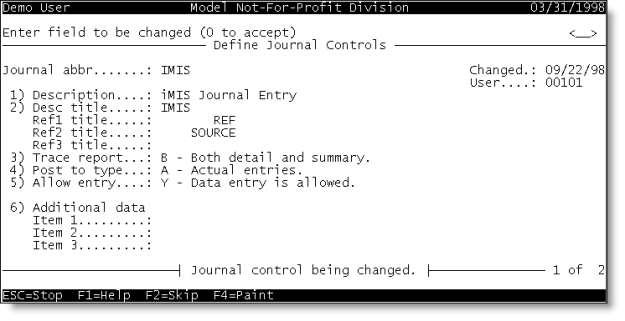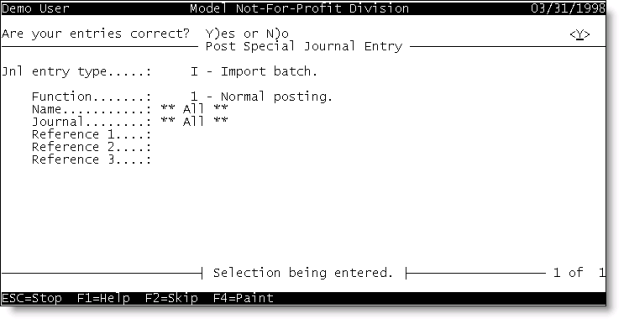FundWare
iMIS Financial Systems (GL) Interface module now provides support to meet import requirements for FundWare DOS version 5.50 or greater. This support is in place in iMIS as of version 4.10.
To set up iMIS for FundWare
The setup steps from iMIS include making appropriate choices on the AR/Cash General Ledger Interface window and an optional step to establish a FUNDWARE general/lookup validation table.
The iMIS setup steps are described in detail below:
Step 1 – Change the GL Interface Type
- From AR/Cash, select Set up module, and click G/L Interface to open the AR/Cash General Ledger Interface window.
- Click Edit.
- From the GL interface type drop-down list, select FundWare.
- Select an option from the Summarize by drop-down list.
- Enter the Output File Path/Name, which dictates how iMIS should name the export/import file and where it should be stored. FundWare specifically looks in the AFW\DATA directory for a file name of GL000X.y where X corresponds to the terminal number. For example, c:\afw\data\gl0001.y assumes a terminal number of 1.
- Click Save.
Step 2 – Set up a special FUNDWARE General Lookup/Validation Table
This step is required if you need to map each iMIS organization code to the FundWare Division code. As the Division code is an integral part of the export file, this step is crucial unless the iMIS organization or entity code already matches the FundWare Division code. It is very possible, especially in the case of multiple funds that more than one iMIS entity (i.e., Fund) may map to a single FundWare Division code.
If the table is properly set up and the output file name contains the substitute character #, the FundWare division, not the iMIS entity, will be the key factor in determining the splitting and generation of the output files.
Note: You do not have to create separate files (i.e., include a # in the output file name) if you have a single legal entity but multiple funds. iMIS treats funds as separate entities, but they are only handled in separate sets of books, not separate files, within FundWare. However, if iMIS transactions may cross over multiple Divisions, it is mandatory to create separate files per division (include the # separator symbol).
- From Customers, select Set up tables > General lookup/validation to open the General lookup/validation window.
- Select (New Table) from the list of table types. The New Table Type window opens.
- Enter a New Table named FUNDWARE and click Save.
- Click New and insert a record for each iMIS organization code, filling in the organization code in the Code field.
- In the Expansion field, enter the appropriate FundWare Division code.
- Click Save.
To set up FundWare
In FundWare, you will need to establish a special iMIS journal. The setup within FundWare includes a simple step to set up a special iMIS customer account to which all accounts receivable amounts will be linked.
- From the General Ledger menu, choose Setup (7) > Define Journal Controls (5).
- Enter A to Add.
- Fill in the values as shown below.
Description: iMIS Journal Entry
Desc title: IMIS Ref1 Title: REF Ref2: SOURCE Trace report: B – Both detail and summary Post to type: A – Actual entries Allow entry: Y – Data entry is allowed.

To create the export file from iMIS (Fundware)
- Generate the general ledger transaction export files using AR/Cash > Process month-end procedures > Create GL Journal.
To import data into Fundware
- From the Administration menu, select Special Processing (5).
- From the Special Processing menu, select Run Program (8).
- Type GLS018 at the Program prompt and press Enter.
- Type Y at the “Is above correct?” message.
The import process will begin and a message should appear giving you the assigned batch code and the filing report name. The filing report, similar to the one displayed below, should be located in the AFW\DATA directory:
Run date: 03/13/11 @ 13:31 Model Not-For-Profit Division Bus date: 01/14/2011 * * * Journal entry trace * * * CS00208.L96 Page 1 Jnl Description / Addnl data items Ref 1 Ref 2 Ref 3 Rate / Resrce Units Amount / Rate Posted amount === ========================= ===== ===== ==== ========== === ========== ============ IMIS 110114-1: FNDW Cash Receipt 110114-1 IMIS 80.00 A01 00-00 1110 IMIS 110114-1: FNDW-AR-AR 110114-1 IMIS 50.00 A01 00-00 1210 IMIS 110114-1: FNDW-AR-FW1 110114-1 IMIS 50.00CR A01 00-00 4110 IMIS 110114-1: FNDW-AR-FW2 110114-1 IMIS 60.00CR A01 00-00 4110 IMIS 110114-1: FNDW-AR-FW3 110114-1 IMIS 20.00CR A01 00-00 4150 Batch 208 posted on 03/13/11 by for business date 01/14/2011 Run date: 03/13/11 @ 13:31 Model Not-For-Profit Division Bus date: 01/14/2011 * * * Journal entry trace * * * CS00208.L96 Page 2 Jnl Period Account Description Debit Credit Balance ===== ======= =============== ======================= ========= ======= ======== IMIS iMIS Journal Entry 01 2011 A01 00-00 1110 Cash in Bank - Banko Uno 80.00 01 2011 A01 00-00 1210 Accounts Receivable 50.00 01 2011 A01 00-00 4110 Contributions 110.00 01 2011 A01 00-00 4150 Annual giving campaigns 20.00 Total for Financial Reporting System 130.00 130.00 .00 Batch 208 posted on 03/13/11 by for business date 01/14/2011 Number of lines printed = 27 *** End of report ***
The imported data is used to create unposted general journal transactions. Once imported, the data can be posted through the following steps:
- From the General Ledger menu, choose Transaction Entry (3).
- From the Transaction Entry menu, choose Post Special Journal Entry (8).
- Type I for Jnl Entry Type, 1 for Function and fill in the remaining fields, as appropriate

Export/Import File Example
The export/import file is a simple fixed file export/import file that contains a single heading line for the Division (one file per Division), a document header line for each new transaction created, and detail document lines for each debit or credit entry in the document or transaction.
iMIS will generate a new journal entry and Document Number each time the following is encountered:
- A new transaction date (for Day or Detail summary methods)
- A new batch (for Batch summary methods)
The following export/import example shows a small interface file for two batches across two dates.
DIV=96 SEP=| 1|IMIS|03/15/2011| 4|A01 00-00 1110|110315-1: FNDW Cash Receipt|980310-1|IMIS||120.00| 4|A01 00-00 1210|110315-1: FNDW-AR-AR|110315-1|IMIS||160.00| 4|A01 00-00 4110|110315-1: FNDW-AR-FW1|110315-1|IMIS||-200.00| 4|A01 00-00 4110|110315-1: FNDW-AR-FW2|110315-1|IMIS||-60.00| 4|A01 00-00 4150|110315-1: FNDW-AR-FW3|110315-1|IMIS||-20.00| 1|IMIS|03/16/2011| 4|A01 00-00 1110|110316-1: FNDW Cash Receipt|110316-1|IMIS||80.00| 4|A01 00-00 1210|110316-1: FNDW-AR-AR|110316-1|IMIS||50.00| 4|A01 00-00 4110|110316-1: FNDW-AR-FW1|110316-1|IMIS||-50.00| 4|A01 00-00 4110|110316-1: FNDW-AR-FW2|110316-1|IMIS||-60.00| 4|A01 00-00 4150|110316-1: FNDW-AR-FW3|110316-1|IMIS||-20.00|